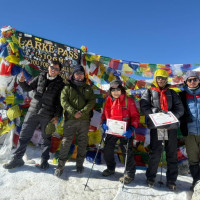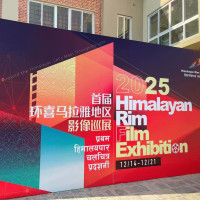- Monday, 15 December 2025
Switzerland Can Inspire Nepal
After finalising my travel plans to Switzerland this month, I heard many people comparing its stunning landscapes to those of Nepal. Intrigued by these descriptions, I felt a strong desire to witness the beauty of Switzerland with my own eyes. I wanted to personally experience the wonders that this captivating country has to offer and bring back memories that would forever reflect the essence of its beauty.
Switzerland's harmonious blend of natural splendor, well-developed infrastructure, and high-quality life makes it an irresistible destination for visitors. Interestingly, the geographical structure and environment of Switzerland are often compared to that of Nepal, creating a sense of familiarity for many Nepalis. Some even envision the potential for Nepal to emulate Switzerland's level of development.
Now, as this scribe embarks on the journey, an opportunity arises to explore this captivating destination firsthand. Over the job of one week, the itinerary includes visits to the captivating cities of Lausanne and Bern. Let us delve into the narrative of this scribe's eyes, unraveling the beauty and essence of Switzerland.
Country of water
Switzerland left a lasting impression on me with its stunning lakes and rivers, adorned with greenish water flowing directly from glaciers. This captivating sight solidified its reputation as the "country of water."
During my trip, I had the opportunity to visit Lake Geneva in Lausanne and the Aare River in Bern. It was remarkable to witness how people embraced the water, particularly at the Aare River, where locals, especially youth and children, joyfully celebrated the arrival of summer by swimming. The cleanliness of the water astonished me, as not a single piece of garbage could be seen, despite the river encircling the old town of Bern. Observing people swimming in the river, I couldn't help but feel amazed by their close bond with the water.
Throughout my journey, I had the privilege of having a Swiss journalist friend, Anand Chandrasekhar, who shared insightful information about Switzerland's water systems. He highlighted the country's commitment to providing clean and safe drinking water, extending even to tap water. Switzerland's strict regulations and monitoring processes ensure that tap water meets the highest quality standards. Anand mentioned that the river water is so clean that it can be consumed directly.
One fascinating aspect I discovered was the accessibility and affordability of water in Switzerland. The country is famous for its public water fountains, which can be found scattered across cities, towns, and even remote areas. These fountains offer free drinking water, sourced from natural springs or treated tap water. I encountered a unique fountain in front of the parliament building, where children were gleefully playing in the refreshing water.
Due to its proximity to the nearby mountains, the water in Switzerland is refreshingly cold, adding to the overall experience and making it even more enjoyable to drink.

Architectural heritage
Switzerland's commitment to preserving its historical architecture and cultural heritage is evident in the well-maintained old houses and unique designs found throughout the country. The preservation of these buildings not only adds to the aesthetic appeal but also serves as a testament to Switzerland's rich history and cultural identity.
Switzerland takes pride in maintaining the authenticity of traditional architecture, such as Swiss chalets and historic buildings, which can be seen in towns and villages. These structures showcase intricate details and architectural styles from different eras and provide a sense of connection with the past.
During my tour of the federal city of Bern, Anand explained the significance of the old town, a UNESCO World Heritage Site, renowned for its exceptionally well-preserved medieval architecture. The cobbled streets, arcades, and sandstone buildings with ornate facades, including the famous Zytglogge (Clock Tower), are a testament to the city's historical and cultural significance. Anand emphasized that construction in the heritage site follows specific guidelines to preserve its integrity.
Iconic Swiss chalets are also a highlight of Switzerland's architectural landscape, especially in mountainous regions. These traditional wooden houses with sloping roofs, overhanging eaves, and decorative woodwork showcase the unique charm of the country's rural areas. In cities like Lausanne and Geneva, I also encountered decorative houses with ornate doorways, carved wooden balconies, and intricate stonework.
While these architectural treasures are admired, Anand mentioned that the trend of living in apartments has become more prevalent due to the limited availability of land in city areas. Constructing such elaborate houses has become more feasible only for the affluent population.
Impressive transportation system
Switzerland's public transportation system is truly impressive, offering a high standard of efficiency and extensive coverage throughout the country. The network encompasses various modes of transportation, including trains, trams, buses, and boats.
Swiss Federal Railways (SBB) operates a renowned train network that connects major cities, towns, and even remote mountain regions. These trains are celebrated for their punctuality, comfort, and scenic routes, providing breathtaking views of Switzerland's landscapes. I had the opportunity to travel with SBB, including an experience on a two-floor train. As I journeyed from Bern to Lausanne, I marveled at the sight of beautiful houses, farms, and lakes, as the train smoothly traversed underground sections and navigated up and downhill stretches. It made me ponder whether Nepal could develop such an extensive railway network in the future, connecting mountains to the terai region.

In addition to trains, Switzerland boasts reputable tram and bus systems, primarily serving urban areas. Trams are commonly found in larger cities, offering convenient transportation within urban centers. Buses complement the tram networks and ensure connectivity to areas not served by trams. Due to the efficiency of public transportation, private vehicle usage is relatively low, with parking issues being a significant factor. This reliance on public transport promotes a more active lifestyle, as individuals often have to walk to and from transit stops. Moreover, it contributes to their physical fitness. However, it is worth noting that despite the prevalence of public transportation, emissions from vehicles still pose an environmental challenge.
While I did not have the chance to explore mountainous areas, I learned that Switzerland also offers Mountain Railways and Cable Cars as transportation options. Switzerland's lakes and rivers further enhance its transportation offerings, with opportunities for scenic boat rides. It is even possible to travel from Geneva to France by boat.
To facilitate exploration for visitors, the Swiss Travel Pass has been introduced. This pass allows unlimited travel on the Swiss Travel System network.
Overall, Switzerland's public transportation system is exceptionally well-coordinated, reliable, and renowned for its cleanliness and comfort. It provides an efficient means to explore the country, with seamless connectivity between urban centers, rural areas, and popular tourist destinations.
Swiss Federalism
According to UN estimates, Switzerland's current population is around 8.6 million people, and the country's area is only 39,997 square kilometers, making it smaller than Nepal.
Despite its relatively small size and population, Switzerland has implemented a successful federalism system. It is a federal republic with a form of government known as Swiss federalism, which has been a fundamental aspect of Swiss governance since the adoption of the Swiss Federal Constitution in 1848.
It is a federal republic composed of 26 different cantons. Each canton has its constitution, government, and legislature, and they have a certain level of autonomy. However, collectively, these cantons form the nation of Switzerland. The Swiss Confederation, as it is officially known, is recognised as a sovereign state and a member of various international organisations, including the United Nations.
Swiss federalism has played a crucial role in maintaining political stability, fostering diversity, and accommodating different linguistic, cultural, and regional identities within the country, a Swiss citizen shared.
Multilingual Country
Like other people, I also thought earlier that Switzerland might have any one national language as Nepali is our national language. But, along with the plan of the trip, I knew that there is no single official language used in Switzerland.
I landed in Geneva and reached Laussane which are French-speaking zone and reached later Bern which is a German-speaking zone. German-speaking people are found more comfortable with English than French. Switzerland is a landlocked country located at the confluence of Western, Central, and Southern Europe. It is bordered by Italy to the south, France to the west, Germany to the north, and Austria and Liechtenstein to the east.
As it is close to these countries the border area people used to speak their neighbouring languages German, French, Italian, and Romansh. These are the four official languages of Switzerland. The majority of the Swiss population speaks German, which is followed by French, Italian, and Roman respectively.
Education and Health services are free in Switzerland. Citizens can take education freely from government schools in their language. There are private schools mainly for the English language. But many people prefer to learn in government schools because the cost of private schools is high.
Swiss are in lap of luxury
After my trip, I came to realize that the people of Switzerland truly prioritise their quality of life. This conclusion was drawn from observing their relaxed demeanor at work, their active engagement in outdoor activities, and their strong focus on health and well-being.
The beautiful landscapes and access to nature in Switzerland attract individuals of all ages. The country's well-maintained infrastructure, including walking paths and public transportation, contributes to the ease of outdoor mobility.

I was impressed by Swiss beauty. Anand mentioned that many Swiss people admire the natural beauty of Nepal. He said that Nepal's nature is wilder in comparison to Switzerland and is not as meticulously manicured or decorated.
During my visit, I noticed a high level of mobility among older individuals and children, as they could be seen frequently in parks and public transportation. According to the journalist, the country's healthcare system, social support, and overall well-being contribute to the active lifestyles of older individuals. Many older Swiss people continue to engage in various activities and maintain a sense of vitality and participation in society.
Contrary to my initial assumption that the people of Switzerland would be consumed by work due to the country's high per capita income, I discovered that Switzerland has a relatively high rate of part-time work among women compared to some other countries. Part-time work offers flexibility and enables women to balance their work and family responsibilities. It is common for women to choose part-time employment, especially when raising children or caring for family members. I found they spend fewer hours working but are punctual on time.
Another surprising thing I noticed in Switzerland is that, despite being a prosperous nation, Swiss households generally prefer to handle their domestic tasks and responsibilities without hiring external help. The journalist explained that Swiss society values self-sufficiency and individual responsibility, leading many households to manage their household chores, including cleaning, cooking, and general maintenance, themselves. The relatively high cost of employing domestic staff in Switzerland may be a contributing factor to this cultural preference.
I also discovered that Swiss society has a liberal attitude toward personal relationships. Public displays of affection between couples, such as kissing, holding hands, and hugging, are considered normal and acceptable in daily life. It is common to witness such displays of affection in public spaces like parks, streets, and public transportation, which may be uncommon or frowned upon in our society.
In conclusion, Switzerland indeed offers a remarkable combination of natural beauty, cultural heritage, efficient infrastructure, and a laid-back lifestyle. Its ability to balance tradition and modernity is one of its strengths, contributing to its appeal to people from around the world.
While Nepal has its own distinct culture and natural landscapes, there can be valuable lessons to learn from Switzerland's approach to infrastructure development. Given the similarities in geographical structure between the two countries, adopting certain aspects of Switzerland's infrastructure planning and implementation could potentially benefit Nepal.
By studying Switzerland's successful practices in areas such as transportation, urban planning, and environmental conservation, Nepal can adapt and apply suitable strategies to enhance its infrastructure. It's important to consider the unique context and needs of Nepal while drawing inspiration from other countries.
Ultimately, the goal should be to foster sustainable development and improve the quality of life for the people of Nepal while preserving and celebrating its own rich cultural heritage and natural beauty.
(The author is a journalist at The Rising Nepal.)

















